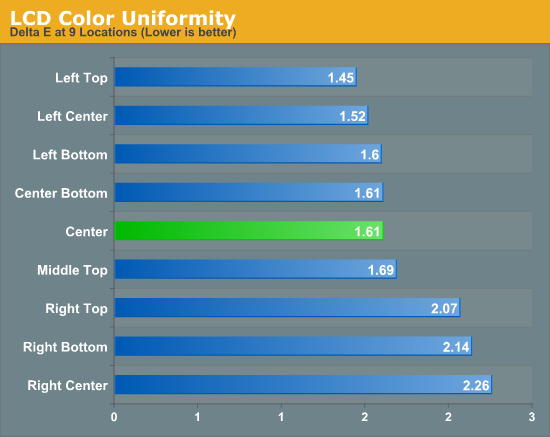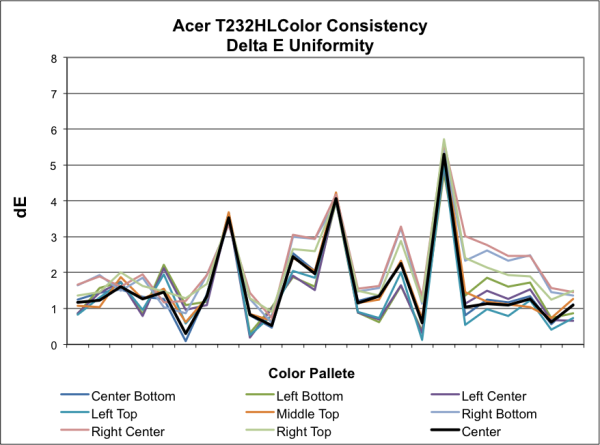Acer T232HL - Touch Comes to the Desktop
by Chris Heinonen on February 6, 2013 9:00 AM ESTDisplay Uniformity
For some reason, display uniformity is where I see a big issue with the Acer T232HL. Using a 5x5 ANSI grid, there is a clear drop in light output on the right side of the screen. While the center is at 200 nits, this whole column of values is below 180 nits, for at least a 10% reduction in light output.
| Top | ||||||
| Left | 218.2 | 215.4 | 197.2 | 172.3 | 188.1 | Right |
| 206.1 | 206.4 | 192.9 | 179.9 | 188.9 | ||
| 213.2 | 207.3 | 199.7 | 179.0 | 179.5 | ||
| 207.5 | 206.1 | 193.4 | 180.8 | 187.9 | ||
| 217.9 | 209.8 | 187.5 | 167.9 | 193.5 | ||
| Bottom | ||||||
Additionally the left side of the screen is really bright, leading to variations across the screen of up to 50.3 nits. This is a huge difference and one that is easily noticeable by average users. I really haven’t seen anything come close to this before, as usually the smaller differences in screen brightness are something I can accept. Looking strictly at the average values the screen looks good, but with the raw values and the surface chart you can see that something is clearly wrong here.
Looking at the black uniformity this issue is still there. It’s not as easy to see because of the lower numbers, but you can see it drop in the same area as before. The incredibly bright spot at the bottom is a bit strange, but I did the reading multiple times to verify that it was correct. All of the corners except for the upper-right have a good bit of light bleed in them as well.
Because both black and white levels have issues in the same part of the screen, contrast uniformity is actually pretty good on the Acer! That’s a bit of damning with faint praise, but since the contrast ratios are very good, it is a bit of a bright side. There is a big drop in the center-bottom reading, but overall the contrast stays pretty close to the 1000:1 level that we measured earlier.
As expected, the weird uniformity issues are here to mess with the color uniformity as well. The average dE for the screen is 1.77 relative to the 1.61 for the center, but the average for the right side is 2.16, a good amount above the center figure. The largest issue seems to be in the grayscale, as the right side produces the three worst results for the grayscale on the whole. All of the values stay at or below 3.0, but it is still much worse on that side than on the center or left side of the display.

Unfortunately, the Acer has a serious issue with panel uniformity, one that could be the result of a number of things. In the end, it is a serious flaw on the display and one that I haven’t seen be so bad in the past.















66 Comments
View All Comments
EJ257 - Wednesday, February 6, 2013 - link
Or just put a label on the bezel that say "Screen coated with contact poison"DanNeely - Wednesday, February 6, 2013 - link
*laugh*expect people to read*laugh*not to mention expecting them to believe it*laugh*After a few shocks most will get the hint.
cjs150 - Wednesday, February 6, 2013 - link
Take away the touch screen and what you have is a poor monitor. Out of the box it is just not good enough, with correct calibration it becomes adequate and because of the touch gimmick overpricedThen there is the touch gimmick. On my work computer, which only has a 17" screen, I have placed at a comfortable distance to read, which means to touch it I would have to lean forward. On a bigger screen it would be even further back.
W8 on the desktop will no doubt be a benefit for chiropractors and physiotherapists having to deal with the RPI injuries caused in the workplace caused by dealing with touch screen, for anyone else touch on a desktop is of very doubtful use.
Homeles - Wednesday, February 6, 2013 - link
There's essentially a whole half of an operating system that is designed around touch. There are plenty of applications where a touch screen is useful. It is unfortunate that you appear to be unable to come up with any besides the asinine benefit of lining the pockets of doctors.Zak - Wednesday, February 6, 2013 - link
@Homeles: I take it you actually tried using a large desktop monitor with touch GUI for real work and extended period of time and actually liked it?Kiste - Thursday, February 7, 2013 - link
Neither chiropractors nor physiotherapists are usually doctors. In fact, chiropractors are mere quacks.Other than that, why don't you name a couple of these applications where a touch screen is useful and offers a clear benefit over mouse on a desktop computer?
.
cjs150 - Thursday, February 7, 2013 - link
Homeles: if you look at tablets and smartphones there are many examples of applications that work well with touch but when you are talking about a WORK desktop you should consider what the majority of people actually do on the computer:email
word processing
data entry
excel
graphic manipulation (if you work in media)
Graphic manipulation requires precision which lends itself to a graphic tablet and the rest involve typing which means a keyboard and if you ever tried word processing using touch you will understand why a mouse and a keyboard is better
ejdrouillard - Wednesday, February 6, 2013 - link
If I'm spending over $500 on a monitor, I expect way more than 1080p.Golgatha - Wednesday, February 6, 2013 - link
For a primary display, I would absolutely not want a touch screen. I agree with the previous posters about kids. I have 2 of them and I have to clean the tablet, iTouch, and laptop screens (not to mention my desktop's mouse) on a regular basis. 24hrs and that screen would be filthy.Now if I could have a cheap secondary screen that was wireless, I might be interested as it could replace a tablet in the house. The range on such a device would need to be pretty exceptional though.
HardwareDufus - Wednesday, February 6, 2013 - link
Actually I plan on buying this monitor to preemptively solve crimes like Tom Cruise in Minority Report.